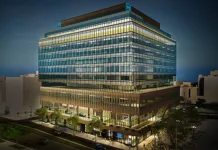
As the pandemic continues on, the future of retail has taken a sharp turn to continually enforce the need for traditional properties, such as indoor shopping malls, to be used in diverse ways while focusing on the community.
Mark Taylor, a Principal at the global architect firm Mg2 and an expert in the field of community environments, has been thinking about the next steps for future developments. Taylor, who specializes in multi-purpose interdisciplinary concepts that go beyond the traditional ideologies of a mall, is ahead of the real estate and design new model with his work this year with Washington Square in Seattle and Brentwood in Vancouver, British Columbia.
“A captive audience awaits the evolution of these shopping mall sites,” Taylor said. “In order to capitalize on this unique position, developers need to re-engage with what specific communities need, shifting away from the monoculture of retail-only uses and embracing a more well-rounded mix of housing, office, and hospitality.”
Numbers show how consumer behaviors are changing. Over Black Friday weekend, in-store shopping took a back seat to online buying. According to a National Retail Federation survey released Tuesday, an estimated186.4 million consumers took advantage of the Thanksgiving holiday weekend and shopped in-store and online this year.
While the overall number of shoppers from Thanksgiving through Cyber Monday dropped slightly from 189.6 million in an unusually robust 2019, this figure is still significantly higher than the 165.8 million shoppers in 2018.
More: Residential, Condo Real Estate Grows Again in October While Hotels Struggle
More: Whitmer Renews Call for $100 Million State COVID Stimulus Package
More: Study Outlines Projects to Attract Business, Visitors to Grand Rapids Area
As expected, in-store shopping was down given both the state of the pandemic as well as the number of retailers who opted to close on Thanksgiving Day. With consumer traffic moving to online channels, the number of in-store shoppers on Thanksgiving Day dropped by 55 percent from last year and those on Black Friday dropped by 37 percent. An earlier NRF survey found that a large majority (70 percent) of holiday shoppers say they feel safe shopping in stores this holiday season given the precautions retailers have taken for COVID-19.
Taylor took a few minutes to share his thoughts on malls, consumers and the future with Corp! Magazine:
Q: Retail has truly changed, and malls are seeing what likely is the most significant impact, especially in 2020. What is the future for the enclosed mall? Are outdoor-style malls going to fare better?
A: Outdoor malls, otherwise known as Lifestyle Centers, have been on the rise for the past 20 years or so, as people crave more authentic and increasing urban experiences. This trend will likely continue, especially with our growing awareness of how the virus spreads. But this trend was also happening because we had too many enclosed malls across the US, and they all offered a more or less formulaic experience. Despite the challenges enclosed malls face, they will have a part to play post-pandemic. Enclosed malls will continue to protect from the weather. However, to stay competitive, they will need to find a new way to connect with the community it serves. Less formula-driven and more community-centric.
Q: How should old-time malls respond to coronavirus? Can they get through this with any kind of updates?
A: Enclosed malls need to respond to the coronavirus by upgrading the filtration systems and providing more air movement thru space. One advantage that malls have is the full-time maintenance staff available to keep surfaces, benches, and door handles, etc., clean. If mall owners can earn patrons’ trust with an aggressive message of virus protection, they will gain confidence. Mall developers can also offer new programs for curbside pick-up where they embrace it as an amenity moving forward rather than a short term fix. Retail space in a mall will contract, and when it does, this presents an opportunity to do something new with the leftover space. This is where mall owners need to get creative and test new concepts. Opening the door to uses, they may not generally found at a mall, like healthcare or education uses. Maybe even a public library.
Q: What does 2021 and beyond look like?
A: Looking beyond, some malls will fail, and some malls will succeed. But one thing is certain, and all malls will change with the new forces put into play by the rapid adoption of e-commerce, a pandemic-induced recession, and the right-sizing of the US’s retail footprint. As designers of retail development, we see a real shift toward mixed-use communities with thoughtful placemaking. This will happen at differing scales depending on the location. Mall owners who embrace the complexities of a mixed-use development for their properties will be rewarded with higher land values and patrons/ residents who think of these places as home.





